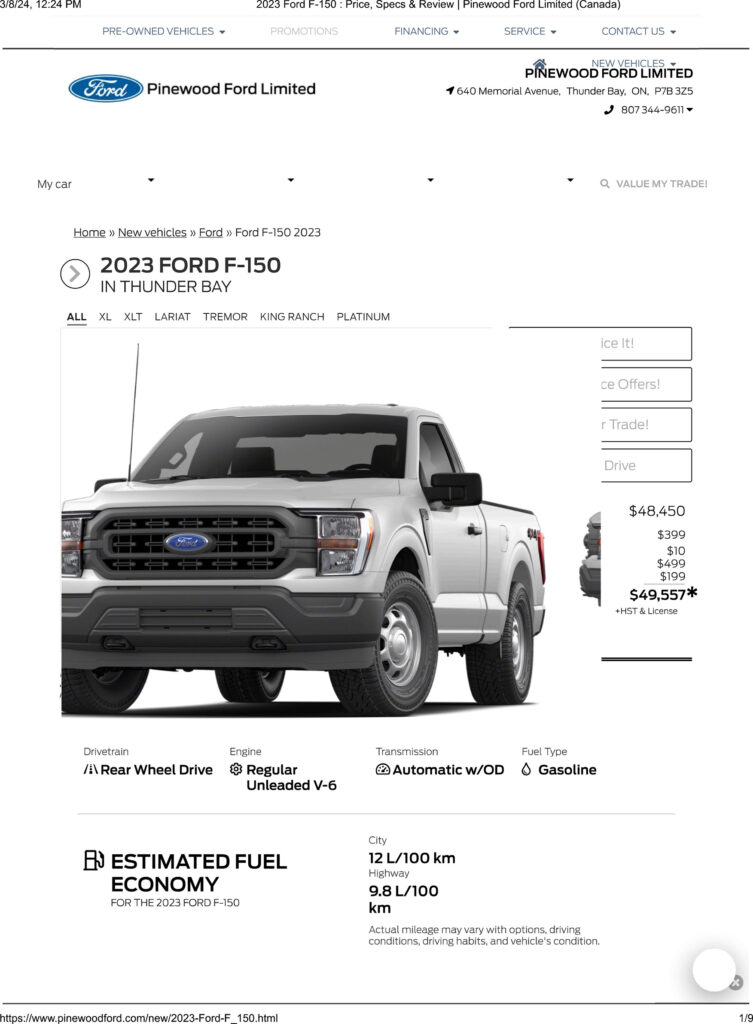Lets see…$100,000 each . Now what is the price of a brand new Internal Combustion Engine powered F-150 at Pinewood Ford?
OK…my math skills are pretty rusty but $100,000 looks like a 100% price premium for this electric pickup truck. In other words, double the cost. And that is MSRP. I am sure that the City of Thunder Bay could get that price down by tendering out the purchase and having businesses bid on the sale.
City of Thunder Bay only paying 25% of the cost while other levels of government pick up the remaining 75%? And where do the other levels of government get their cash? The same place that the City of Thunder Bay gets its cash. The taxpayer. Remember, municipal, provincial or federal, there is only one taxpayer. All of their funds come out of the same pocket.
Do you honestly believe that anyone, including all governments can afford a 100% increase in fleet vehicle purchase costs? There is no way. The few EVs that are sold right now is because of government subsidies. Everywhere in the world where those subsidies have been removed, EV sales numbers have dropped.
The City of Thunder Bay always has its hand out for free money from senior levels of government. Those senior levels of government run deficits right now. Large deficits. At some point all of that ‘free cash’ that the provincial and federal taxpayers ( you and me) send to Thunder Bay will have to cease. You can only tax the population soooo much. You cannot get blood from stone.
How are EV sales going?
How much money can car makers lose before their shareholders start to speak up?
EVs cost waaaay too much. They are waaaay too big. The bigger the vehicle, the bigger the battery required to make it go. The bigger the battery, the more the vehicle weighs. The more the vehicle weighs, the bigger the battery required.
The Lightning weighs 6,500 pounds—more than 35 percent more than the gas-powered model. That’s in large part because of an immovable weight at its core: an 1,800-pound battery. Part of that is just the nature of electric vehicles: The Tesla Model 3 weighs 1,000 pounds more than a Honda Civic. The more luxurious Tesla Model S weighs 1,200 pounds more than a Lexus ES 350.
But when the car is as big as an F-150, apparently, the weight gain gets bigger. When rival GMC’s electric Hummer hits lots, that behemoth will weigh more than 9,000 pounds.
Americans buy 900,000 Ford F-150s a year; if electrification can chip into those sales, – Slate.com
Then there is the battery. How much does the battery add to the cost of the vehicle?
Searching Ford parts online, I found pricing for both the extended-range battery and the standard-range battery at my local Ford dealer.
First, the extended-range battery, the one with up to 320 miles of range, is currently priced at $35,960.
Next, the standard-range battery, with 230 miles of range, is currently priced at $28,556. – pickuptrucktalk.com
Yes….the 320 mile (514 km) F-150 Lightning’s battery would cost $36,000 US ($48, 500 Can) to replace. That is the cost of an ordinary Internal Combustion Engine powered F-150 right now. Yes, the battery is the price of anew truck. Damage the battery in a collision, the vehicle is a right-off. I am sure your vehicle insurance company will want to know that. Not part of the discussion?
Then there is the cost of upgrading the world’s electricity grid to handle the electricity demand that EVs will produce. Billions of dollars and many decades of time to get that done.
Soooo what are governments doing? They are going to ban sales of ICE vehicles sometime in the future. Want a vehicle, buy an EV, It will be your only choice.
EVs have issues that are rarely mentioned. Fire. Higher insurance costs. Higher repair costs. The possibility, that when the battery needs to get replaced, the value of your vehicle will be less than the cost of the new battery. Ten years and your vehicle is scrap? Yes.
Fire…EVs have a habit of bursting into flames. A fire that, as of right now with today’s technology, cannot be extinguished. If your EV is parked inside a structure and that EV starts to burn, that structure is very likely to go up in flames as well. Home owners insurance companies might be interested in this.
If that EV is parked near other vehicles and that EV starts burning, other cars are very likely to be damaged as well. These two City of Thunder Bay F-150 Lightning EV s should be parked and charged outside. Parking and charging them inside the Transit garage puts every other vehicle parked in that building at risk. Yes, these vehicles are that dangerous.
Then there are the electric transit buses. Sigh….Range matters. Fire hazard matters. Costs of repairs matter.
I could go on and on. Do your own research Take a look. I think its all a big mistake.
previous related posts here

